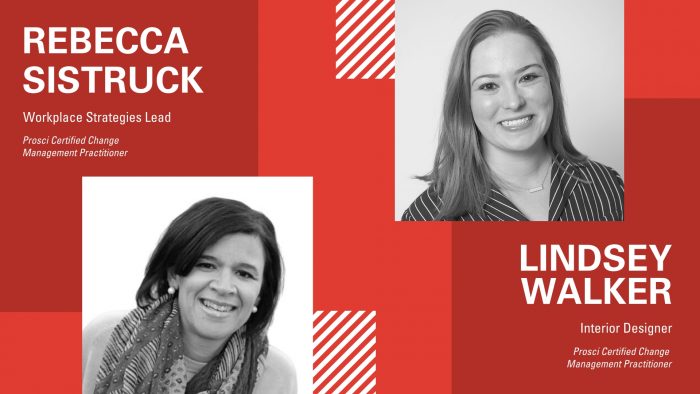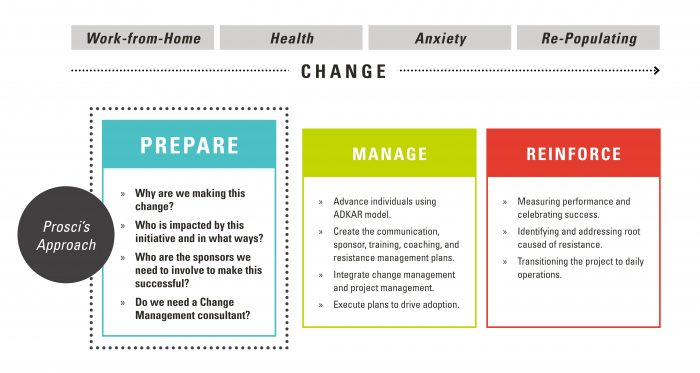If you have not already done so, you can read Part 1 of this series here.
As we continue this series, Little’s in-house change management experts, Rebecca Sistruck and Lindsey Walker answer questions about how change management is being influenced by COVID-19. They provide helpful advice to help you prepare for the unanticipated changes that are to come, with clearly outlined steps. Rebecca and Lindsey also address the “new normal” as we transition back into the workplace.
With an excess of advice, tips, articles, and more in the media, we aim to help you filter that information into a digestible, understandable strategy that you can implement as you re-populate into the workplace.

HOW DO YOU SEE CHANGE MANAGEMENT BEING INFLUENCED IN OUR CURRENT ENVIRONMENT WITH COVID-19 AND AS ORGANIZATIONS PLAN TO RE-ENTER THE WORKPLACE?
When change is led and managed effectively, it encourages a practice of empathy. Today’s environment of uncertainty requires an extra dose of understanding. What types of newly found home and work-life changes will we be faced with that may influence how people adapt in challenging times? The COVID-19 crisis continues to blur the line between professional and personal life experiences. This brings levels of uncertainty that can be unnerving. The Prosci ADKAR model already supports this premise: “awareness of the need for change to occur, desire to participate, knowledge of how to change, ability to implement required skills and behaviors, and reinforcement to sustain the change.”
“Empathy is connecting to emotions that underpin an experience” – Brene Brown
The COVID-19 crisis provides us the opportunity to practice empathy more intently and learn about the inherent resiliency within ourselves to adapt. As planners, we are accustomed to working through strategies and project schedules that are long term and may not always accommodate fluidity or the frequency, of course, corrections that COVID-19 may bring. This requires leading clients through change with transparency and sound judgment based on the credible information we know at any given point in time. The phased re-entry into the workplace is a great example of this process. We are learning new information as we go. We are reading and writing the playbook and adapting more easily with some level of uncertainty. Some change management strategies will be short term (15, 30, 60 days) and designed to adapt to new information more readily. Our current change, COVID-19 impact, will likely remain fluid and continue to evolve from day to day, week to week.
WHAT ADVICE CAN YOU PROVIDE TO PREPARE, AND REMAIN AGILE FOR THE UNANTICIPATED CHANGE WITHIN THE WORKPLACE?
Change that occurs on a global scale is unsettling but revealing. Change can be uncomfortable but pivotal. Fyodor Dostoevsky, a Russian novelist, explains “Times of Crisis, of disruption or constructive change, are not only predictable but desirable. They mean growth. Taking a new step, uttering a new word, is what people fear most.” Without change, our innovative spirit does not flourish, and our resourcefulness is not tested. As problem solvers, we seek out the opportunity for change.

Recommendations for planning through the unanticipated times of COVID-19:
IDENTIFY
- Identify vulnerable workers
- Identify essential “in office” workers beginning with an agreed-upon percentage of the overall employee population
DEVELOP
- Develop contingency plans for short- and long-term phased transition
- Develop required changes to your workplace to protect the safety, well-being, and health of employees through a workplace analysis
EVALUATE
- Assess your workplace transition safety plans, work-from-home long term guidelines, cleaning protocols and ability to contact trace (Completed, In Progress, Not Started)
- Assess the needs of staff as the phased transition takes place (e.g. childcare, well-being)
- Assess your cognitive empathy, to understand how someone else sees the current circumstances (also referred to as perspective-taking)
ACHIEVE
- Follow crafted change management strategy and communication plan to provide ongoing and transparent information
- Follow the advice and guidance of subject matter experts (e.g. state and local government, CDC)
THINKING ABOUT THE “NEW NORMAL” AS WE TRANSITION BACK INTO THE WORKPLACE, THERE IS A LOT OF INFORMATION AND ADVICE OUT THERE FROM GOVERNMENT REGULATORY ORGANIZATIONS TO YOUR OWN EMPLOYER OR BUILDING MANAGEMENT. HOW DO WE FILTER THIS INFORMATION AND IMPLEMENT A STRONG STRATEGY FOR RE-POPULATION INTO THE WORKPLACE?
As we enter a transition phase or the “new normal”, synthesizing ongoing knowledge while planning will be an innovative but complex way of operating. This will require leaders and change practitioners to leverage both tactical and strategic thinking skillsets. At a personal and organizational level, we should be quickly identifying our most credible information sources, including regulatory and governing entities that influence our respective lives and industries now, as well as in the future. Constantly prioritizing these directives while still aligning with our strategic goals will determine how we implement and execute changes within our own personal lives and the work we do collectively.

Workforce Preparation Guide:
- Engage your executive sponsor – continue to be steady, empathetic, and transparent when sharing business knowledge.
- Identify your “Change” core team – include subject matter expertise that will lead specific focus areas (e.g. remote work, policy changes, facilities and operations, communications).
- Develop potential timelines – along with your change management strategy and communications plan, craft short- and long-term projections based on credible sources.
- Assess comfort and change – Both individuals and teams are taking part in this change process. Provide tools and resources to support (ADKAR assessments).
Keep a watchful eye out for Part 3: Implementing guidelines, behavior change, and applying the ADKAR model to workplace change moving forward.
Sources:
The Prosci Adkar® Model
Prosci Inc – https://www.prosci.com/adkar
The Global Leader in Change Management Solutions
Prosci Inc – https://www.prosci.com/
How To Manage Change in a Crisis With No Time To Plan Lisa Kempton – https://blog.prosci.com/how-to-manage-change-in-a-crisis-with-no-time-to-plan?utm_campaign=Individual+-+Inbound+Funnel&utm_source=hs_email&utm_medium=email&utm_content=86680507&_hsenc=p2ANqtz-_D_P6nBpbwnihPKdVqAOWq0MAP9r39UygaO_Xu8M20TfDMs5L_BfiKZ0jH8Pcx7_3evDUAL5PU_7skSYWGDN3JG5zpp-beKN8k2FACfDKiQNGaC20&_hsmi=86823885

